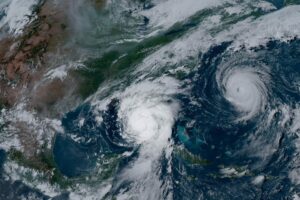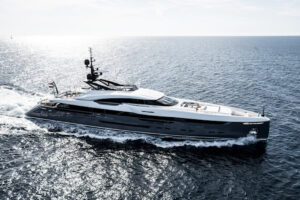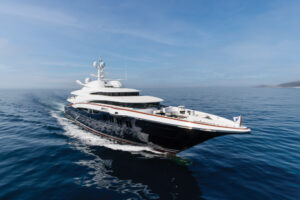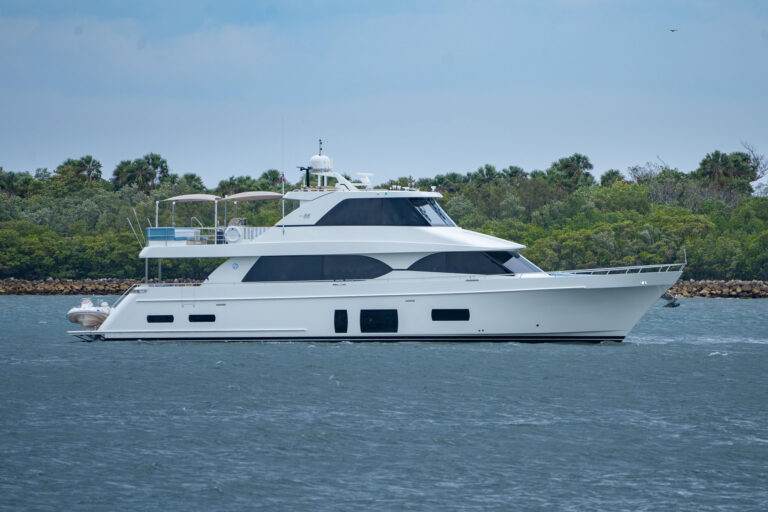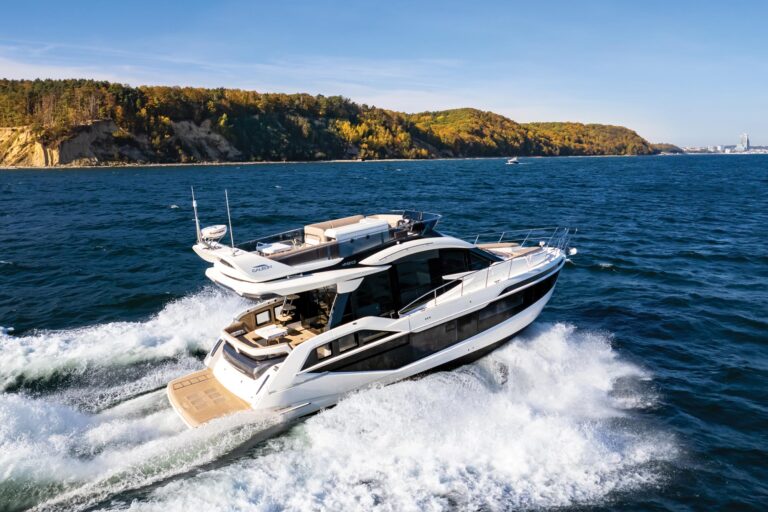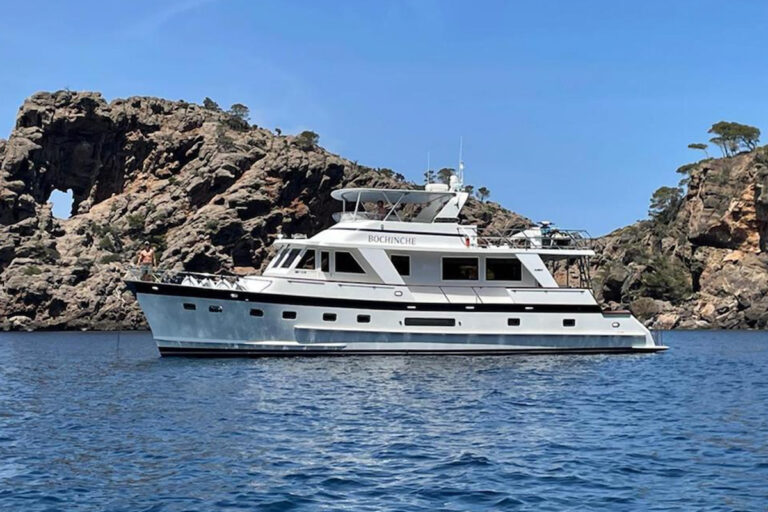The well-preserved old city of Savannah, with its great port, looms prominently over the Atlantic frontier of Georgia. Unknown to most, this famous city stands on the northern edge of a shoreline that, I predict, will shine as the last undeveloped stretch on the eastern seaboard of the United States, the last remaining corridor of nature, of wetlands, of islands and waters teeming with sea creatures.
Coastal Georgia is not particularly long-only 100 nautical miles-but the shores of Georgia’s barrier islands and the tidal rivers twist and turn for 2,300 miles. This means a lot of water, most of which flows swiftly through the convoluted panoramas of salt marshes backed by forests. Attractions are easy to sample. Right on the borders of urban Savannah, yachtsmen will find untouched wetlands existing side by side with old architectural gems near top-quality yacht facilities. The untrodden beaches of a protected barrier island, the Wassaw Island Wildlife Refuge, face the Atlantic within a few miles of the Isle of Hope National Historic District, with its Old South antebellum architecture. Isle of Hope itself is scarcely five miles from the Palmer Johnson Yacht Yard in Thunderbolt, where maxis and mega- yachts receive first-class treatment.
All these wonders can be approached by the Intracoastal Waterway, which crosses the Savannah River and then swings by Thunderbolt and Isle of Hope. Even yachts too large to use the waterway can steam to Palmer Johnson’s from the ocean via Wassaw Sound. The sound runs by sandy shores lined with palmetto forests on Wassaw Island to the south, and the pristine beach of the uninhabited Williamson Island to the north. After it hops over a 10-foot bar (at low water springs), the marked channel through Wassaw Sound merges with the deep Wilmington River. On the eastern shore of the river stretch the docks of the Savannah Yacht Club, founded in 1869 and one of the oldest clubs in the United States.
Reciprocal dockage at Savannah Yacht Club may be an option, but yachts can always tie up at the Palmer Johnson Marina, a modern and convenient facility in Thunderbolt, half a mile farther west. Situated under the eves of The River’s End, a restaurant of national renown, the marina shares a large, deep basin with the Palmer Johnson yacht yard, which opened in 1992. Most of Palmer Johnson’s clients are the world’s largest yachts, sail and power, taking advantage of a Synchrolift capable of dry docking vessels displacing as much as 1,100 tons and a 215-foot spray booth.
Although the Palmer Johnson yacht yard dominates as the main employer, Thunderbolt has served working sea craft for a long time. Thunderbolt village came into existence in 1733 with the arrival of General James E. Oglethorpe, the founder of Savannah. Nothing remains from the fortifications Oglethorpe organized to protect the brand-new Savannah from the Spanish. Revolutionary War and Civil War batteries vanished, too, as Thunderbolt developed into a fishing port. Until recently, hundreds of shrimpers were based along the mile-long town waterfront. Because of shrinking stocks of shrimp, the fleet now numbers a handful, and fishing boat docks have been replaced by small marinas and waterfront condominiums.
With all the dockage available for yachts, Thunderbolt makes an excellent base for touring local landmarks. Midnight in the Garden of Good and Evil, a movie and bestseller by John Berendt about the seamy side of Savannah, transformed the city into a tourist destination. Bonaventure Cemetery, one of the attractions featured in both works, is a couple of miles along the river from Thunderbolt and once sheltered a very much alive John Muir, later the founder of Sierra Club. He camped there in 1867 and loved the wildlife teeming in live oaks that drip curtains of Spanish moss amid entwined, flowering vines. The oaks, the moss and the vines all remain despite daily busloads of tourists. Visitors are less conspicuous in the National Historic Landmark District in downtown Savannah, only minutes away by car.
The colonial town of Savannah was laid out in the squares beloved by the British military. Twenty of the village squares Oglethorpe originally drew in the 1730s remain. Instead of the cows and donkeys of the settlers, the squares shaded by avenues of grand live oaks now shelter monuments dedicated to important people and historical events. Curiously, the notables commemorated in granite do not correspond with the names of the squares. A great boulder on the grave of Tomochichi, the Yamacraw people’s chief who gave up the area to Oglethorpe in exchange for Georgia’s barrier islands, rests in Wright Square. The monument of the Polish Count Casimir Pulaski, who died for the American cause during the British siege of Savannah in 1779, stands in Monterey Square. General Nathaniel Greene, prominent in American Revolutionary War, has a square named for him, but his monument actually rises in Johnson Square, and so on.
Superbly maintained examples of early American architecture border the squares, and the Historic District abuts Factor’s Walk, which housed cotton dealers in the 18th century, when the fluffy stuff was as good as gold. The red brick Cotton Exchange still towers over many venerable shipping agencies. Walking old Savannah is a lasting aesthetic experience best done after leaving your vessel a few miles away. Tying up on the river is limited to the docks at the Hyatt Regency and Westin Savannah hotels.
While the heart of Savannah throbs day and night, visiting yachtsmen can escape to the relaxed ambience of the Old South just a few miles farther south, at Isle of Hope. The docks of its only marina nestle under a low bluff where giant live oaks shade classic Southern homes, many of antebellum vintage, included in the Isle of Hope Historic District. Within a 20-minute walk from Isle of Hope Marina, you can plunge through the arched gates of Wormsloe Plantation, where you encounter a 1.5-mile long tunnel of hundreds of live oaks locking branches overhead. At the homestead, take a good look at the old house’s walls, which are attractively textured with embedded fragments of oyster shells. Early colonists made this tabby mixture themselves. Crushed oyster shells were burned to produce lime, which combined with sand and water, then solidified into tough house blocks.
Wassaw Island marks one of the most remarkable achievements of the Nature Conservancy of Georgia. The group paid $1 million for this 5-mile-long island in 1969, and the federal government protected it as a wildlife refuge. Despite the heavily populated Savannah nearby, Wassaw Island was never seriously logged and represents a nearly pristine example of the coastal environment. Twenty miles of trails wind through wild, tangled maritime forest, and along seven miles of beaches along the Atlantic shore.
Yachts in Wassaw Sound can anchor off the island’s north tip and land a tender by the hulk of the 1898 Fort Morgan, sinking into sands where a century of fierce tidal currents has eroded the land. The weather can easily make the anchorage in Wassaw Sound untenable; Romerly Marsh Creek is better-suited for longer visits. From there, a tender can head into Old Romerly Marsh Channel, which winds through wild marshes to New Cut, a channel dug up in the 1800s that eventually exits on Wassaw Creek. The winding stream just south of the cut dries at spring tides, so even a shallow boat may have to wait for the tide to rise. Being stuck quietly in this area can bring rewards-the glimpse of an otter or a mink, and definitely an alligator. Bottlenose dolphins, too, venture up these shoal rivulets and sometimes thrust themselves upon a bank, mud flying, in pursuit of a panicked quarry.
This silting channel was, in the 19th century, part of the inner route south. New Cut was also known as Parson’s Cut, after the owners of Wassaw island. After landing at the Park Headquarters dock, look at the trail map. The Parson family still occupies a parcel of land and are the only inhabitants on this wild island of fresh water sloughs, tangled woods, and high dunes covered by forest and fronted by beaches where only the deer and raccoons leave tracks. Loggerhead turtles add to the beach footprint patterns when they arrive to lay eggs from May through July. Seven species of migrating warblers land in the forests to rest, as do waterfowl on the safe, sheltered sloughs. Two osprey couples have set up huge nests overlooking the anchorage at the south arm of Wassaw Creek, taking advantage of this nook protected from heavy winter blows.
Wassaw Creek, providing a sheltered anchorage for yachts as long as 60 feet, spills into a deep Odingsell River wide enough for shrimp trawlers and large yachts. These larger vessels usually approach from the Atlantic through Ossabaw Sound via the marked North Channel bothered only by the bar with a least depth of 9 feet. After passing Wassaw Island, this channel continues west to join the Intracoastal Waterway, so moderate-size boats can reach the area from the west. High tides often rising 8 to 10 feet above the charted depths transform either approach into a deep, safe waterway.
A yacht cruising by Savannah can experience scenery from antebellum architecture to raw nature in a compact area. Sweep your dividers set at 10 nautical miles from Thunderbolt, and you will have covered it all. Use NOAA charts 11509 to navigate the approaches from the ICW or the Atlantic and 11512 to explore the anchorages in Odingsell River, Wassaw Creek or Romerly Marsh Creek.

